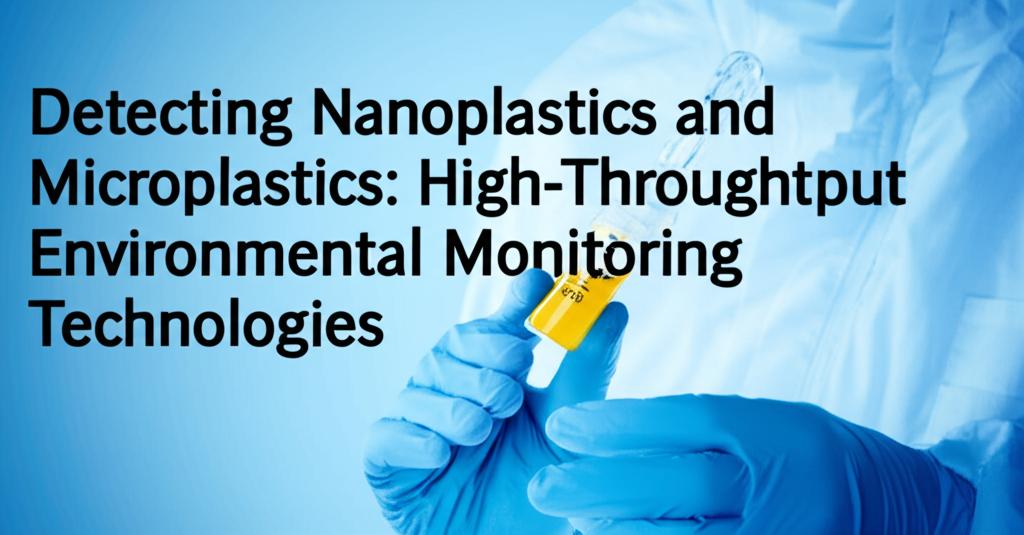The pervasive nature of nanoplastics and microplastics (NMPs) in our environment, from the deepest oceans to the air we breathe and even within our bodies, presents a significant and growing challenge to ecosystems and human health. Accurately detecting, identifying, and quantifying these tiny plastic particles, especially those at the nanoscale, has been a major hurdle for researchers. However, recent advancements in high-throughput environmental monitoring technologies are paving the way for more efficient and comprehensive analysis.
Traditional methods for NMP detection, such as visual and optical microscopy, scanning electron microscopy (SEM), and gas chromatography-mass spectrometry, often face limitations in terms of speed, sensitivity, and the ability to handle complex environmental samples. Spectroscopic techniques, particularly Fourier-transform infrared (FTIR) spectroscopy and Raman spectroscopy, have become increasingly popular due to their potential for rapid, non-destructive, and high-throughput analysis.
Emerging Spectroscopic and Imaging Techniques:Recent developments have focused on enhancing these spectroscopic methods and combining them with other technologies:
- Advanced Raman Spectroscopy: Several advanced Raman-based techniques are showing great promise.
Surface-Enhanced Raman Scattering (SERS): This technique significantly boosts the Raman signal, enabling the detection of individual nanoplastics as small as tens of nanometers, particularly in water. However, its effectiveness can be limited by the diffraction limit for particles smaller than 100 nm.
Raman Tweezers (RTs): This method manipulates and analyzes single particles, though it also faces diffraction limitations.
Tip-Enhanced Raman Scattering (TERS): TERS offers very high spatial resolution, crucial for nanoplastic detection and even single-molecule imaging. While successful for microplastics, its application to nanoplastics is still developing.
Raman Mapping/Imaging (RM/RI): By combining image analysis with advanced algorithms, RM/RI techniques can overcome the diffraction limit and detect plastic particles down to several tens of nanometers. This method is considered vital for single-particle analysis, offering high-throughput capabilities for large-scale imaging.
* Stimulated Raman Scattering (SRS) Microscopy: This powerful optical imaging technique allows for rapid analysis of nanoplastics with high sensitivity and specificity. SRS microscopy is significantly faster than conventional Raman imaging and can detect nanoplastics below 100 nm. Coupled with automated plastic identification algorithms, it enables high-throughput, single-particle level analysis.
- Flow Imaging Microscopy (FIM): FIM is proving valuable for monitoring microplastics in settings like plastic recycling facilities and wastewater treatment plants. It captures high-resolution images of individual particles and quickly calculates various properties like size, shape, and morphology. This allows for the rapid analysis of numerous samples.
- Hyperspectral Imaging: This emerging technique is also gaining traction for its potential in rapid and non-destructive analysis of NMPs.
- Hollow-Laser Desorption/Ionization Mass Spectrometry (HoLDI-MS): A recently developed 3D-printed HoLDI-MS test platform offers a cost-effective, high-throughput method for detecting NMPs. This technology overcomes some limitations of traditional mass spectrometry by allowing direct analysis of samples without extensive preparation. It is also suitable for detecting waterborne plastic particles and aims to facilitate global data comparison and validation.
- Pyrolysis Gas Chromatography-Mass Spectrometry (Py-GC-MS): This technique is effective for identifying polymer types and quantities in microplastic particles, even at low concentrations, due to its high sensitivity. It can be used for both qualitative and quantitative analysis.
- Acoustofluidics: The EchoGrid technology utilizes acoustic trapping to enrich microplastics from environmental samples. By combining microfluidic structures with acoustic waves, this method can process larger fluid volumes and concentrate low-concentration particles, which is highly relevant for environmental monitoring where contaminants are often found in small amounts within large sample volumes.
To address the time-consuming and labor-intensive nature of some detection techniques, machine learning (ML) and automation are increasingly being adopted. ML algorithms can process large datasets from spectroscopic or imaging analyses with greater speed and accuracy, identifying patterns that distinguish NMPs from other particles. This is particularly useful for analyzing data from SEM, fluorescence, Raman spectroscopy, and FTIR. ML models are being developed with tailored strategies to optimize plastic detection and expand monitoring capabilities, leveraging the unique molecular fingerprinting abilities of spectroscopic methods.
Challenges and Future Directions:Despite these advancements, challenges remain. Issues like fluorescent interference, the need for sample pretreatment, and inherent technical limitations of some methods need to be addressed. There is a significant need for the standardization and harmonization of detection protocols to ensure data comparability and reliability across different laboratories worldwide. The development of portable and cost-effective detection tools is also crucial for wider environmental monitoring.
Future efforts will likely focus on:
- Further improving the sensitivity and specificity of detection methods, especially for nanoplastics.
- Developing more robust and automated sample preparation techniques.
- Integrating multiple analytical techniques to provide more comprehensive characterization of NMPs.
- Expanding the use of AI and machine learning for faster and more accurate data analysis and particle identification.
- Refining portable and field-deployable instruments for real-time monitoring.
- Continued interdisciplinary collaboration between chemists, biologists, engineers, and environmental scientists to drive innovation.
Addressing the global issue of plastic pollution requires a deeper understanding of the distribution, fate, and impact of NMPs in the environment. The ongoing development of high-throughput monitoring technologies is critical to achieving this understanding and informing effective mitigation strategies.

